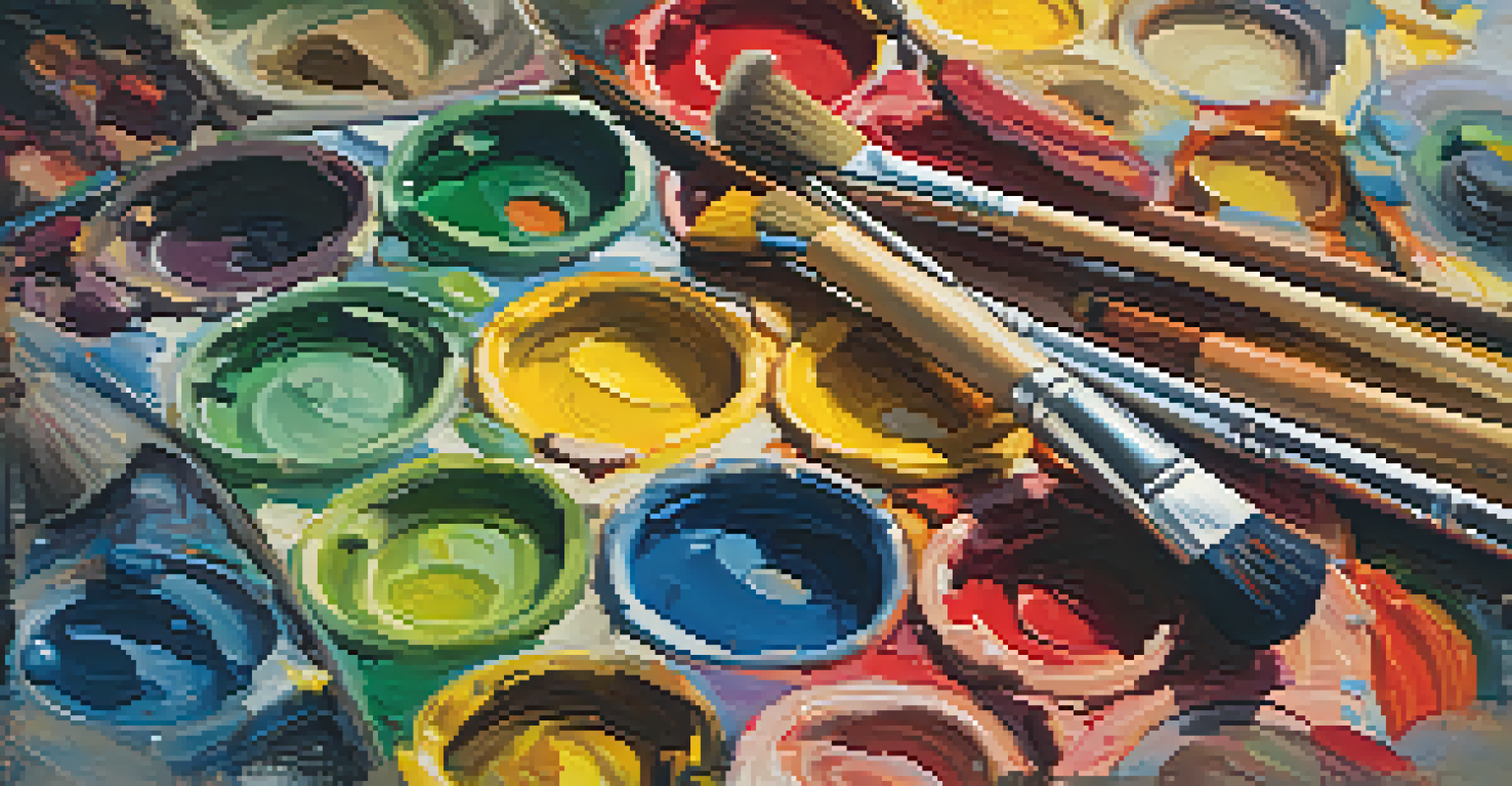The Evolution of Art Criticism: From Classic to Contemporary

Defining Art Criticism: A Historical Perspective
Art criticism has roots that stretch back to ancient civilizations, where philosophers like Plato and Aristotle began analyzing art's purpose and value. They debated whether art should imitate life or express deeper truths, laying the groundwork for future discourse. As societies evolved, so did the approach to art, with critics becoming essential voices in shaping public perception and appreciation.
The greatest artist is not necessarily the one who creates the best work, but the one who inspires others to create.
In the Renaissance, art criticism took a more structured form, with critics evaluating works based on technical skill and adherence to classical ideals. This era celebrated artists like Michelangelo and Leonardo da Vinci, whose works were scrutinized not just for beauty but for their mastery of technique. Criticism became a way to elevate art to a status worthy of intellectual discussion.
Fast forward to the Enlightenment, where art criticism began to emphasize individual taste and subjective experience. Critics such as Denis Diderot introduced a more personal touch, encouraging audiences to connect emotionally with art. This shift marked a significant change, allowing art to be experienced not just as a visual spectacle but as a catalyst for personal reflection.
The Role of Art Critics in the 19th Century
The 19th century marked a transformative period for art criticism, with the rise of influential figures like John Ruskin and Walter Pater. These critics moved beyond mere technical evaluation, arguing for the importance of understanding an artist's intent and the cultural context of a work. Their writings encouraged a deeper engagement with art, sparking discussions that resonated with broader societal changes.

During this time, the advent of new artistic movements, such as Impressionism, challenged traditional norms and provoked strong reactions from critics. Some embraced these changes, while others condemned them, reflecting the dynamic tension between innovation and convention. This era highlighted the critic's role as both a defender of the established and a champion of the new.
Art Criticism's Historical Evolution
Art criticism has transformed from ancient philosophical debates to modern interpretations that embrace diverse perspectives and societal changes.
As art became more diverse and accessible, critics began to recognize the importance of audience engagement. They sought to bridge the gap between artists and the public, using their platforms to educate and inform. This democratization of art criticism allowed more voices to be heard, paving the way for future discourse.
Modernism: A New Lens on Art Criticism
With the dawn of the 20th century, modernism revolutionized art and the role of critics. Movements like Cubism and Surrealism prompted critics to rethink their approaches, as traditional criteria no longer applied. Critics like Clement Greenberg and Harold Rosenberg emerged, advocating for a deeper understanding of abstraction and the artist's process.
Art is the most beautiful of all lies; it is a wonderful illusion that brings us closer to the truth.
Modernist criticism emphasized the importance of context, arguing that art could not be separated from its historical and cultural background. This shift allowed for a more nuanced interpretation of works, as critics began to explore how social, political, and personal factors influenced artistic expression. It was a time when art was seen as a reflection of the complexities of modern life.
Additionally, the rise of art theory brought a new vocabulary to criticism, enabling a more sophisticated dialogue around contemporary works. Critics began to engage with philosophical concepts, creating a rich tapestry of ideas that surrounded art. This intellectual engagement marked a significant evolution in how art was analyzed and understood.
Postmodernism and the Critique of Criticism
Postmodernism introduced a radical shift in art criticism, challenging the very foundations established by modernists. Critics began to question the authority of the critic, arguing that interpretations are subjective and shaped by the viewer's experiences. This democratization of criticism meant that anyone could voice their opinions, leading to diverse perspectives on what art could be.
The rise of multimedia and installation art further complicated traditional criticism. Critics had to adapt their methods to analyze works that incorporated performance, technology, and audience interaction. This evolution reflected a broader cultural shift toward inclusivity and interactivity in the arts, reshaping the critic's role in the process.
Digital Media's Impact on Criticism
The rise of digital platforms has democratized art criticism, allowing a broader range of voices and immediate engagement with audiences.
Moreover, postmodern criticism often embraced irony and humor, contrasting sharply with the seriousness of previous eras. This playful approach encouraged audiences to engage with art on different levels, allowing for multiple interpretations. The result was a rich dialogue that expanded the boundaries of art criticism beyond mere evaluation.
The Influence of Digital Media on Art Criticism
The advent of digital media has had a profound impact on art criticism, shifting how critics convey their ideas and engage with audiences. Social media platforms like Instagram and Twitter have become vital spaces for sharing critiques, enabling immediate feedback and interaction. This accessibility has allowed a new generation of critics to emerge, often blurring the lines between artist and audience.
Digital platforms have also democratized art criticism, giving voice to those who may have been marginalized in traditional spaces. Critics from diverse backgrounds can now share their perspectives, enriching the dialogue around contemporary art. This shift has resulted in a more inclusive and varied landscape, where multiple voices contribute to the understanding of art.
However, the rapid pace of digital media has posed challenges for critics, as they must balance depth with brevity. In a world where attention spans are short, crafting thoughtful critiques that resonate quickly has become essential. This evolution requires critics to be not only knowledgeable but also adaptable to the ever-changing landscape of art and technology.
The Future of Art Criticism: Trends and Predictions
As we look to the future, art criticism is likely to continue evolving in exciting ways. The fusion of technology and art will likely shape how critics approach their work, with virtual reality and artificial intelligence opening new avenues for exploration. These advancements may lead to innovative forms of critique that challenge traditional boundaries and redefine the critic's role.
Moreover, the growing emphasis on social issues and activism within contemporary art will influence criticism. Critics may increasingly focus on how art engages with themes like climate change, racial justice, and gender equality. This shift could lead to a more socially conscious form of criticism, where the impact of art on society takes center stage.
Future Trends in Art Criticism
As technology and social issues shape contemporary art, criticism is poised to evolve, emphasizing innovative forms and socially conscious themes.
Ultimately, the future of art criticism will depend on the ongoing dialogue between artists, critics, and audiences. As the landscape continues to evolve, we can expect new voices and perspectives to emerge, enriching our understanding of art and its place in the world. This dynamic interplay will keep art criticism relevant and impactful for years to come.
Conclusion: The Enduring Importance of Art Criticism
Reflecting on the evolution of art criticism, it's clear that it has played a vital role in shaping our understanding of art throughout history. From ancient philosophers to contemporary digital critics, the discourse surrounding art has continually adapted to societal changes. This adaptability is a testament to the enduring importance of criticism in the art world.
Art criticism not only helps audiences appreciate and understand works of art but also encourages artists to push boundaries and explore new ideas. By engaging with critiques, artists can gain insights into their work, fostering a dialogue that enriches the creative process. This mutual influence between critics and artists is essential for the ongoing development of art.

As we move forward, the challenge for critics will be to remain open-minded and responsive to the ever-changing landscape of art. Embracing new forms and perspectives will ensure that art criticism continues to thrive, providing valuable insights that resonate with audiences and artists alike. In this way, art criticism will remain a crucial element in the conversation about art's role in society.